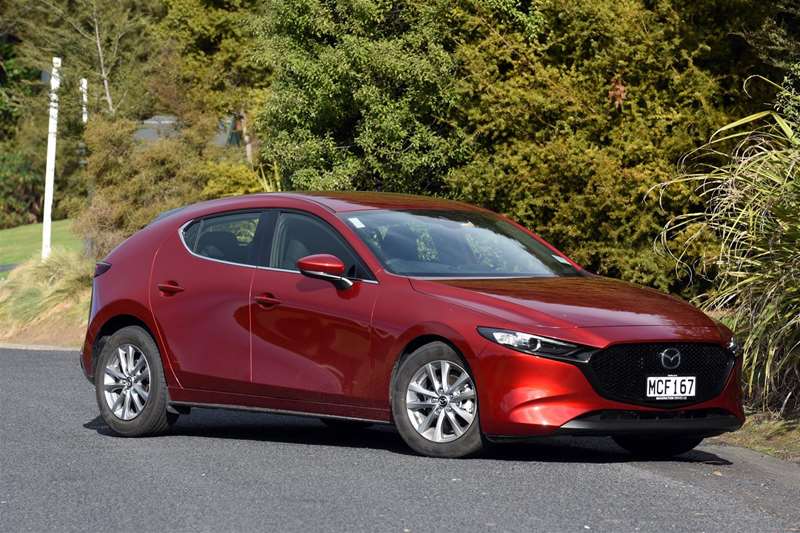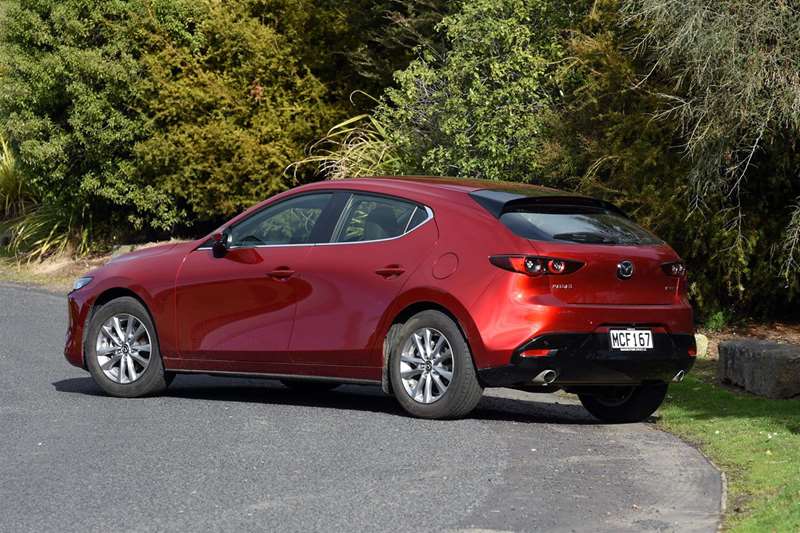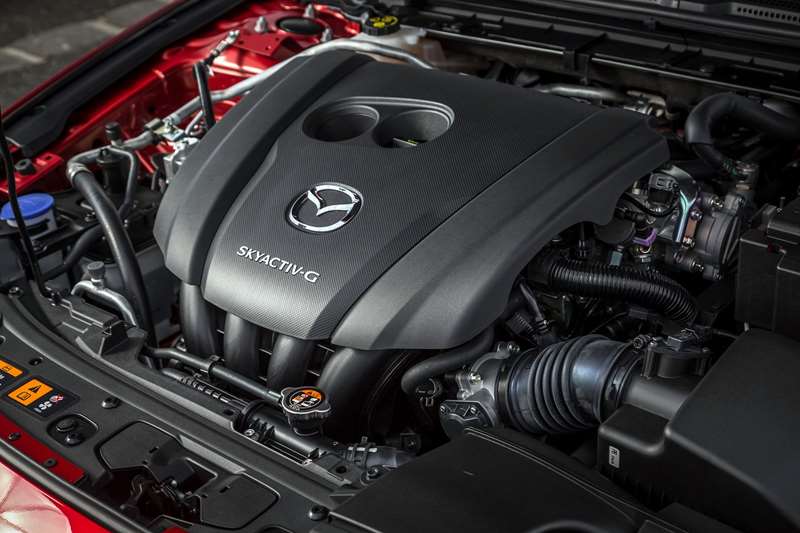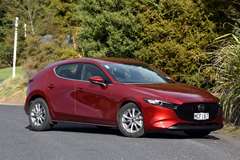Beautifully built and finished, Mazda’s new version of the ‘‘3’’ is a step up from its predecessor. David Thomson finds out whether its performance is as good as its looks.
AT A GLANCE
What’s new?
A new underlying platform, fresh exterior look and all-new interior mark the latest, fourth-generation Mazda3.
Available here in hatchback and four-door sedan guise, the latest ‘‘3’’ features a slightly longer wheelbase than its predecessor. Though there has been no change in overall length or width, the hatchbacks stand a little lower than before, while the sedan is now the same length as the hatch rather than a little longer.
The new platform is substantially stiffer, and there have been suspension changes at the rear, where a technically sophisticated independent suspension is replaced by a simpler and more compact torsion beam set-up.
Drivetrains for now are the familiar choices of 2.0-litre or 2.5-litre SkyActiv petrol engines, delivering power and torque to the front wheels via a six-speed automatic transmission. Producing 116kW and 200Nm in its latest guide, the 2.0-litre powers the $36,595 GSX (hatch or sedan). The 2.5-litre unit, offering 139kW and 252Nm, is fitted to the $40,795 GTX and $48,795 Limited versions.
Looking ahead to 2020, a new flagship model will feature Mazda’s radical new SkyActiv-X engine. Unveiled in advanced prototype form just two months ago, this engine deploys new compression-ignition technology that is said to enable a combination of petrol power with diesel-like torque and economy.
Returning to the here and now, this test covers the GSX and GTX hatchbacks and the Limited saloon, and so spans both of the current engines, along with both body shapes and all three specification levels.
What’s it like to look at?
Mazda3 chief designer Yasutake Tsuchida says the styling of this new model is all about the evolution of Mazda’s Kodo design approach from one of lines to one of reflections.
What he means becomes clear on the flanks of this latest Mazda3, where the use of concave styling panels causes the sides of the car to shimmer and reflect the light. As far as the hatchback variant is concerned, the other distinguishing feature of the new Mazda3 is a substantial C-pillar, this time with a convex panel design that reflects the light in a quite different way. The sedan,
meantime, takes a more conservative approach at the rear.
Both look sharp, but which is more attractive will be a matter of taste; the sedan is more traditionally elegant and less heavily haunched, but the bolder hatchback look is closer to that of the RX Vision concept car that provided inspiration for this new Mazda look.
What’s it like inside?
Even at entry level there’s a plush feel to the new Mazda3’s cabin that sets it apart both from its predecessor, and from other non-European models in its class. This is exemplified by the soft-touch imitation leather finish across the top of the well-padded dashboard, but is also apparent in the more general use of high-grade materials throughout, and in detailing such as felt lining for
the glovebox.
The new cabin is minimalist and driver-focused in look and layout. Dial clutter is minimised by providing a head-up display and adopting a main digital instrument panel. Positioning of the new 8.8-inch centre display screen a little further from the driver assists with managing distraction.
Unlike most such devices today, the Mazda’s main display is not a touchscreen. The access point for a new Mazda infotainment system, it is operated via a rotary dial and associated buttons on the centre console. On test, I found the initial setup of the system fiddly. It’s just as well the voice control system works well, as the ability to access many functions via the usual controls while
the car is moving is limited. While Mazda’s restricting this access to the driver is justifiable on safety grounds, it is frustrating when there is a passenger alongside.
The driving position is low and sporty, and there’s a decent centre armrest/door bin between the front seats. The seats themselves are comfortable and supportive at every level of specification, and plushest on the Limited, where the seats are leather-trimmed and power-adjusting.
Despite the slight gain in wheelbase, the rear of the hatchback’s cabin is only averagely roomy by class standards, and the high waistline makes the back seats feel slightly hemmed in. Similarly, boot space — at 295-litres — is adequate rather than generous. In the case of the sedan, the rear has superior headroom, and boot space is a much better 444-litres.
What comes as standard?
The new Mazda 3 is very well specified: the GSX features LED head and tail lights, keyless entry and push button start, the digital instrument screen and head up display, and single zone manual air-conditioning.
The 8.8-inch centre display is the access point for satellite navigation, the reversing camera and an 8-speaker sound system.
The entry-level safety specification includes auto-dipping headlights, adaptive radar cruise control with intelligent speed assist, blind spot monitoring, rear cross traffic alert, forward collision warning, smart braking support (with pedestrian and cyclist recognition), lane keeping assistance, and speed limit sign recognition.
The GTX adds LED fog lamps, 18-inch alloys, a proximity key, dual zone climate control, rear smart brake support and front parking sensors as well as the 2.5 litre rather than 2.0 litre motor.
The Limited brings all-round LED lighting, leather trim and heated, power-adjusting front seats, a 12-speaker BOSE sound system, a sunroof and paddle-shift gear controls. It is equipped with further safety aids including driver fatigue monitoring, front cross traffic alert and Mazda’s ‘cruising and traffic support’ system to assist with lane positioning and following distances at slower
speeds.
What’s it like to drive?
Perhaps the most telling compliment one can pay the new Mazda 3 comes from my experience of driving the 2.0 GSX after time behind the wheel of the 2.5 GTX and Limited. Rather than feeling like the poor cousin to its better appointed, more powerful siblings, the GSX was every bit as fun and engaging to drive.
Sure, with less outright grunt, the GSX needed to be worked harder during spirited driving and up major highway hills. But the 116kW and 200Nm on offer is still ample, so long as one is happy to rev the engine, and make use of the gear lever’s tiptronic shift gate when required.
The two hatchbacks Drivesouth tested were more adjustable under hard cornering than the saloon, but the new Mazda3 still handles very well in either guise, with improvements to the chassis seemingly countering any adverse effects of the revised rear-suspension.
Running on 205/60 R16 tyres rather than the 215/45 R18s fitted to the 2.5-litre models, the GSX doesn’t have the same level of cornering grip. Yet, with less grip, its steering offers better feel. On the other hand, the extra pep of the 2.5-litre models certainly gives them an outright performance edge, and the larger motor works more smoothly with the six-speed automatic transmission.
Ride quality tends towards the firm end of the spectrum for an everyday car, though not to the extent that comfort is unduly impacted. Rather, in return for accepting a little poor-surface patter around town, the Mazda 3 pays back handsomely with fine body control over corrugations at highways speeds.
Noise levels, and especially road roar, are notably subdued compared to the previous Mazda3. This reflects an effort to make the new Mazda3 quieter, an effort so concerted that it influenced interior trim and fabric choices, as well as involving greater use of conventional insulation, new rubber sections between sheets of metal, and new engine mounts.
A final important element of the driving experience is the new Mazda 3’s array of safety aids. These aids are doubtless good news for accident reduction, and features such as adaptive radar cruise control and auto-dipping headlights are absolute boons for convenience.
On the other hand, those of us who prefer to maintain a reasonable level of control may wish to disable an adaptive speed system that slows the car far more at corners than we might need, and applies force against my steering on test when I was crossing a white line on to the verge to allow an emergency services vehicle to pass by. Welcome (and not for Mazda alone) to cars that can
control more of our driving than ever before, and not always to best effect.
Verdict
The previous Mazda3 was very good, and this new one is better still. Visually interesting, beautifully built and finished, packed with advanced technology, and as good to ride in as drive, it’s a great all-round effort.
Photos: David Thomson












